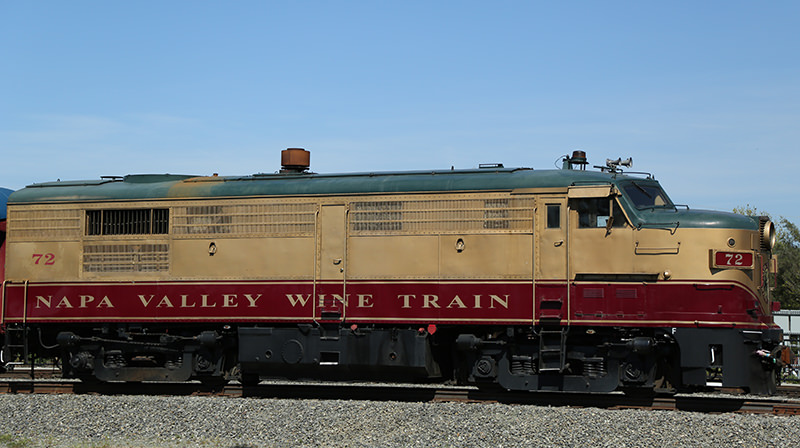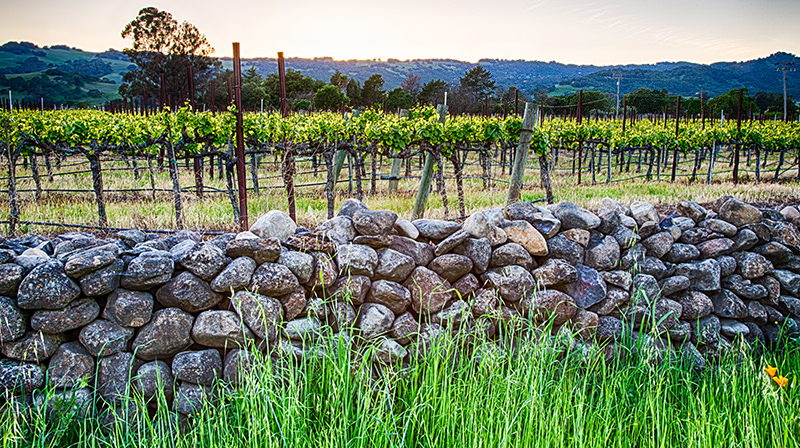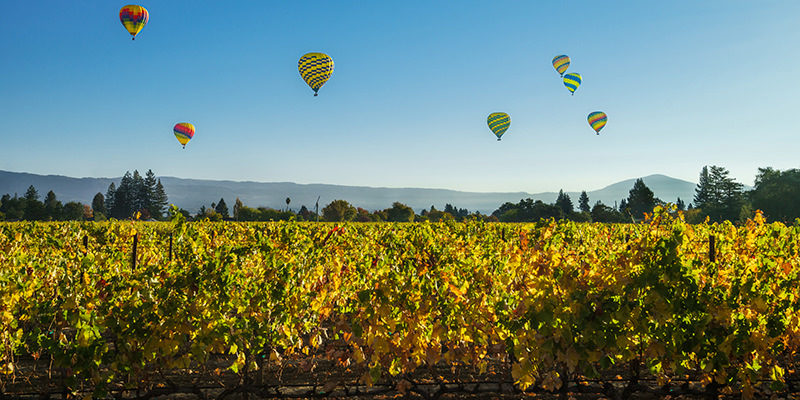It’s time to stop messing around, Napa and Sonoma. You’ve been confusing us all for far too long. Between your charming wineries, rustic bicycle tours, and ubiquitous rolling hills—damn those rolling hills—how are we supposed to tell the difference? How are we supposed to book a well-informed vacation and pledge allegiance to the right wine country? The sensible walking shoes are coming off: it’s time to get in the ring and settle this once and for all.
What Up, Napa?
Napa is a few things—a town, a region (Napa Valley), and home to a bunch of AVAs (American Viticultural Areas) to explore. It’s also, historically, pretty expensive. But that’s because, as we’ll see, Napa is built up to encourage tourism. And where there are multiple hotels, quaint inns, and farm-to-table restaurants, well, prices tend to go up.
According to a yearlong profile by Destination Analysts, in 2014, Napa had 3.3 million visitors, generating $1.63 billion for the county. Fun fact—most of that spending wasn’t on wine (that would be a seriously drunk vacation), but hotels. Really, 72% of the spending in Napa in 2014 was hotel-based, to the tune of $389 a day on average, per guest. The next largest percentage? Retail. That doesn’t mean visitors to Napa are only there for the shopping and Thomas Keller’s restaurant recs. It just means there’s a large tourist infrastructure built up around them, for good reason. Napa Valley wineries encourage well-rounded tourism as a means to get bodies in the wineries, kind of like a Starbucks that lets you use the restroom. Chances are, on your way out, you just might buy a latte.

So what about the wine? Oh yes, Napa has plenty of that, too, 500 wineries and counting (95% are family owned and operated), many of them with tasting rooms—often with appointments and fees required. Expensive, maybe, but there’s some swagger behind the price tags. Among the grapes Napa’s Mediterranean-style climate can grow—Pinot Noir, Merlot, Zinfandel, Chardonnay, and Cabernet Sauvignon—the latter two dominate, and actually beat out their French competition in the now famous, industry-rocking 1976 Judgment of Paris (if you’ve seen Bottle Shock, you’ll know what we’re talking about; you’ll also know what we mean when we say Chris Pine rocked that damn hippie wig).
Long story short, Napa is much more developed than Sonoma, still polished, but booming—possibly even growing too fast, with the Napa planning commission approving 23 new wineries per year (as of 2014). But even with all those wineries, Napa produces only 5% of California’s wines on an annual basis. It’s wine, but it’s also tourism.
Big Boy Wineries: Stag’s Leap, Robert Mondavi, Chateau Montelena
Smaller Wineries: Burgess Cellars (free tasting, by appointment); Artesa Vineyards ($10 to $15); Cartlidge & Browne (free tasting!)
Wine Tasting Price Range: Tastings can range from $10 on the lower end to $50 and up.
Break it Down: Can range from sophisticated wine tour to baller-style stretch SUV strut down Napa’s iconic Highway 29 for a taste of some top quality Cabernets and Chardonnays. But if you’re really into wine, don’t stop with the marquee grapes—or wineries. There are gems and deals to be found in lodging and drinking, it just takes some searching. With 125 restaurants, and a small constellation of Michelin stars, dining options should generally blow your mind, and possibly your wallet.
Bring It, Sonoma
Sonoma may not be as recreationally polished as its Napa neighbor, but then again, trying is the enemy of cool, right? If Napa’s the guy handing out invites to a hot new wine bar, Sonoma’s the guy in jeans and a ragged T-shirt, leaning against a brick wall, glass of wine in hand. “You can come to a tasting if you want. Whatever.”
Okay, to be fair, Sonoma does try—extremely hard, in fact. It just tends to try harder mostly at wine alone, with a casual nod to a tourist industry that’s decidedly more laid back, rustic, winding, quirky. Like Napa, Sonoma’s a town, a region, and home to 17 AVAs, with over 400 wineries. But don’t let it’s laid back attitude fool you. Despite its less touristy tourism, Sonoma County actually attracted 7.5 million visitors in 2014, with everyone spending about $389 a day (housing included). Compare that to $389 a day on hotels alone in Napa, and you get the difference.

Of course, what you gain in dollar power, you lose in options—there are fewer hotels and restaurants, and things are generally less built up. But clearly that’s part of Sonoma’s charm—some people want an all-inclusive resort, some people want a cabana on the beach and total solitude. (And wine. Always wine.)
And as for the wine, whereas Napa tends to champion its Chardonnays and Cabernet Sauvignons, Sonoma revels in variety. With 60,000 acres of wineries (to Napa’s 43,000) and a variety of microclimates, Sonoma’s got plenty of room to make plenty of wine. According to Sonoma County Vintners, Chardonnay dominates production in Sonoma, followed by Sauvignon Blanc (in whites). Cabernet Sauvignon leads reds here too, but competition is much fiercer with varietals like Pinot Noir, Merlot, and Zinfandel. Pinot Blanc, Pinot Gris, Cabernet Franc, and Petit Sirah round out the list. Variety is the spice of Sonoma.
Wineries to Know: Francis Ford Coppola Winery, Ravenswood, Arrowood, Buena Vista (California’s oldest commercial winery), St. Francis
Wine Tasting Price Range: $15-$18
Break it Down: For the bicycled and or bearded, more of a stereotypically hipsterific, rustic tour of wine country, as beautiful as Napa with a bit less polish (which may appeal to some looking for a more hands on, less guided, experience).

